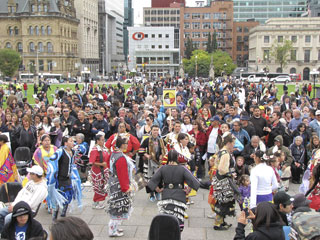First Nations rally for indigenous education funding and support
By Gale Courey Toensing
OTTAWA – First Nations chiefs, elders,
students and thousands of their supporters called on the Canadian
government to increase funding and support for indigenous students’
education.
First Nations leaders from across the country made education their
top priority during the Assembly of First Nations annual meeting in
Winnipeg during the summer. As a follow up, the AFN and the
Kitigan Zibi
Anishinabeg First Nation in Quebec – the largest Algonquin
nation in Canada – declared the week of Sept. 19 as the
National Week of
Action on Education.
The Action Week began Sept. 19 with a walk from Kitigan Zibi
Anishiabeg First Nation to Ottawa, about 100 miles away. Events and
rallies took place across the country during the week.
First Nations chiefs met with around 40 members of parliament from
all parties to present their vision of education for indigenous
students and discuss the stakes and issues regarding the future of
First Nations education.
“The time has come to go beyond the Indian Act (an 1876 statute by
which Canada’s federal government assumed the authority to regulate
Indian affairs and lands) and build a new relationship with Canada.
A relationship built on mutual respect instead of colonialism,” said
Ghislain Picard, chief of the Assembly of First Nations of Québec
and Labrador.
The Action Week culminated Sept. 23 with a rally and a cultural
celebration on Parliament Hill where AFN National Chief Shawn
A-in-chut Atleo, surrounded by chiefs and students, gave a rousing
speech, punctuated by applause and cheers from the demonstrators.
Atleo reminded people that it was not just the ancestors of First
Nations, but also of Canadians who entered into treaties.
“They sat down with one another and in sacred ceremony calling upon
the Creator as witness, forged treaties, treaties that were based on
mutual recognition, mutual respect and care for one another. That’s
also what we’re looking for today from the descendants of those who
forged those treaties so long ago,” Atleo said.
Referring to Canada’s brutal residential schools, Atleo said today’s
young people are learning that their parents and grandparents were
sent away to schools against the will of their parents and their
nations. Canadian Prime Minister Stephen Harper issued a formal
apology in 2008 for the residential schools imposed on the country’s
indigenous people, but survivors are still scarred by the
experience.
“Under the guise of education, under government policy, incredible
amounts of money and political will were spent trying to take our
languages away, disconnect people from our land, our territory and
time spent with the elders. So if education was a tool of
oppression, a tool that held our people down, then I ask all of you
today, not just those gathered here, but all Canada, shouldn’t
education be a tool for freedom for our people, reconnect us with
our land, our territories, with our elders?”
In a teleconference with Native media a day after the rally, Atleo,
a hereditary chief from the Ahousaht First Nation on Vancouver
Island, said the week of action sent a clear message from indigenous
leaders to the Canadian government to provide First Nations students
with quality and culturally relevant education from early childhood
to post-secondary school.
“They’ve been really focused on raising awareness for the need for
fairness and equity for our young people,” Atleo said.
The leaders were well armed with data – some of it provided by the
federal government – to back up their claims that funding for First
Nations students is both inadequate and discriminatory.
The federal government capped First Nations education funding at 2
percent annual growth since 1996 – an amount that does not keep pace
with inflation or with the burgeoning indigenous population. A
disparity of $2,000 or more per pupil exists between First Nations
students and funding non-Native students receive from provincial
governments. First Nations schools receive no resources for
computers, software, libraries, language immersion or support
systems. There is no funding for costs relating to vocational
training, sports and recreations, or to reforms in provincial
programs.
In some isolated areas of the country, there are no schools at all
and in others students have to travel great distances to attend
classes. This is where distance learning and other technology could
be useful, Atleo said.
But needs go beyond money, he said.
“It’s about compelling Canada to change its approach and recognize
our people as being a tremendous potential, not only for First
Nations, but for Canada.”
Closing the gap in education and employment for First Nations
citizens could result in a contribution to Canada’s Gross Domestic
Product of around $179 billion by 2026, Atleo said.
“Canada is really worried right now about how it’s going to respond
to the increasing health care demands as the aging mainstream
population gets older and needs more health care; that population is
creating a big gap in the labor force. So before Canada goes looking
elsewhere around the world for people to fill the labor force, let’s
look in our own back yard and see this exploding indigenous youth
population and let’s support it and invest in their education and
their future, and if we do that everyone will win.”
The First Nations education initiative was supported by the Canadian
Federation of Students, which represents more than 500,000 post
secondary students, the Public Service Alliance of Canada, which
represents 172,000 workers, and the Canadian Union of Public
Employees, which represents more than 600,000 workers.
© 1998 - 2010 Indian Country Today. All Rights Reserved To subscribe or visit go to: http://www.indiancountry.com
